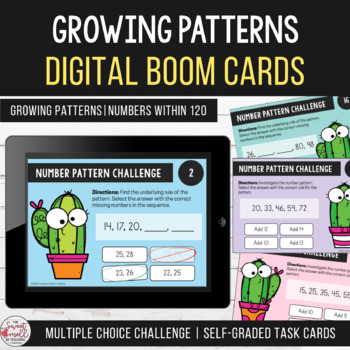Growing Number Pattern Challenge Digital Boom Cards Distance Learning
- PDF
- Internet Activities
Description
Number Pattern Challenge Digital Boom Cards Growing Patterns Numbers within 120 Distance Learning
Students will use their problem-solving skills to identify rules and extend growing number patterns. Students are asked to investigate each number pattern (each pattern shows three or five terms). They will determine the rule behind the pattern and then select the appropriate multiple choice answer. Great activity for math rotations and revision!
This product includes:
• A link to access 25 Digital Task Cards on BOOM Learning℠
• Resource instructions
• Additional answer key in PDF format
This deck includes 2 different activities:
Activity 1 (cards 1, 2, 3, 6, 7, 8, 11, 12, 13, 16, 17, 18, 21, 22, 23)
Students select the answer with the correct missing numbers in the sequence (multiple choice).
Activity 2 (cards 4, 5, 9, 10, 14, 15, 19, 20, 24, 25)
Students select the answer with the correct rule for the number pattern (multiple choice).
**This resource includes a link to access the 25 Digital Task Cards. You will need to create an account on BOOM Learning℠ to use these task cards.
More about BOOM Learning℠
To use Boom Cards, you must be connected to the Internet. Boom Cards play on modern browsers (Chrome, Safari, Firefox, and Edge). Apps are available for Android, iPads, iPhones, and Kindle Fires. For security and privacy, adults must have a Boom Learning account to use and assign Boom Cards. You will be able to assign the Boom Cards you are buying with "Fast Pins," (play provides instant feedback for self-grading Boom Cards). Fast Play is always a free way for students to engage with Boom Cards decks. For additional assignment options you'll need a premium account. If you are new to Boom Learning, you will be offered a free trial of our premium account. Read here for details: http://bit.ly/BoomTrial.
Looking for more resources involving number patterns? You may also be interested in:
• Growing & Shrinking Number Patterns - True or False Challenge Cards
• Growing & Shrinking Number Patterns - Challenge Sheets
If you like this product, you may also be interested in these resources:
Operations & Algebraic Thinking
• Multiplication Games - Memory Cards
• Balance the Equations - True or False Equivalence Challenge Cards
• Balancing Equations - Equivalent Number Sentence Challenge Sheets
• Balance the Equation - Equivalent Number Sentence Jigsaw Activity
Number & Operations in Base Ten
• Rounding Numbers - Task Card Activities
• Addition & Subtraction with Regrouping Activities
• Addition & Subtraction with Regrouping Activities - Back to School Edition
Number & Operations - Fractions
• Comparing Fractions, Decimals & Percents - Comparison Cards & Worksheets
• Fraction and Decimal Games - Memory Cards
Measurement & Data
• Metric Measurement Conversions - True or False Challenge Cards




